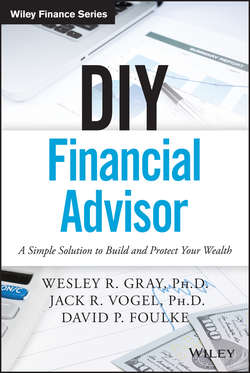DIY Financial Advisor

Реклама. ООО «ЛитРес», ИНН: 7719571260.
Оглавление
Vogel Jack R.. DIY Financial Advisor
Preface
Acknowledgments
Part One. Why You Can Beat the Experts
Chapter 1. Are Experts Trying Too Hard?
Chapter 2. Simple Models Typically Beat the Experts
Chapter 3. Experts Are Biased and Overconfident
Chapter 4. Experts Tell Us Stories, Not Facts
Part Two. How You Can Beat the Experts
Chapter 5. A Framework for Investment Decisions
Chapter 6. A Simple Asset Allocation Model That Works
Chapter 7. A Simple Risk Management Model That Works
Chapter 8. Simple Security Selection Models That Work
Chapter 9. The Do-It-Yourself (DIY) Solution
Chapter 10. Some Practical Advice
Appendix: Analysis Legend
About the Companion Website
About the Authors
WILEY END USER LICENSE AGREEMENT
Отрывок из книги
This book is a synopsis of our research findings developed while serving as a consultant and asset manager for large family offices. By way of background, a family office is a company, or group of people, who manage the wealth a family has gained over generations. The term family office has an element of cachet, and even mystique, because it is usually associated with the mega-wealthy. However, practically speaking, virtually any family that manages its investments – independent of the size of the investment pool – could be considered a family office. The difference is mainly semantic. For example, the term individual investor is often a reference to the head of a household who manages a family's assets. This “individual investor” is a de facto family office – no matter whether this individual investor manages a $10,000 portfolio or a $5,000,000,000 portfolio. The goal is the same as for even the largest family office.
There are benefits and costs to being a family office. The key advantage a family office or, by extension, any individual investor, has over so-called “institutional” investors, is the ability to make long-term investment decisions that maximize after-tax, after-fee risk-adjusted performance, without fear of a misalignment of incentives – those who own the money are the best stewards of the money. By contrast, a professional institutional investor, or “hired gun,” is crippled by a misalignment between the incentives of the owners of capital and those of the investment manager, who has a separate incentive to keep his job, which can create a shorter-term perspective that can conflict with a long-term perspective. The decision that maximizes the after-fee, after-tax, risk-adjusted returns on capital, while optimal for the owner of capital, is not always the optimal decision for a third-party investment manager.
.....
Many less wealthy investors are told that the mega-rich benefit from their access to arcane strategies, hedge funds, and private equity investments. We are here to tell you that this popular and widespread meme has been propagated by salesmen, not by evidence: access to overpriced, opaque, complex, tax-inefficient exposures typically managed by egomaniacs is not an advantage – it is a serious disadvantage!
What matters in investing are avoiding psychology traps and sticking to the FACTS (fees, access, complexity, taxes, and search), a framework we describe in Chapter 5. These simple concepts apply to everyone, not just the ultra-wealthy. The findings of this book are therefore applicable to the middle-class as well as to the mega-rich. Attempting to maintain and grow wealth accumulated over a lifetime is a task that is equally daunting for both individuals and for big name family offices.
.....